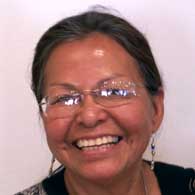Askan, Linda

Half Santa Claran and half Dineh, Linda Askan was born into the Santa Clara Pueblo Summer Moiety as the daughter of Marie and Andy Askan. As Puebloan tradition goes, she grew up with her mother’s family at Santa Clara Pueblo.
Linda’s Tewa name, given to her by Adelaide Sisneros (her grandmother) is Jo Povi, meaning “cactus flower.” Linda attended the Institute of American Indian Arts and worked as a Respiratory Therapy Technician before she decided to become a full-time potter.
Her grandmother and her mother were influential in teaching Linda the traditional ways of making pottery as she grew up. As a child she played with broken pieces of clay. Then she started polishing the broken pieces with a stone. Putting her hands to the clay and creating something with it was a natural evolution after that.
“We would fire together at my grandparents’ corral,” she remembers. The traditional method leads to firing outside over an open fire, using cottonwood, piñon pine and dry horse manure for fuel. She says, “We experience firing visually: paying attention to the fire, making sure it’s evenly burning, being aware the whole time.”
As generations of Pueblo potters have done before her, Linda digs her clay in the hills and coils the shapes by hand (pinching the miniatures). She creates black-on-black and red polychrome pots, plates, wedding vases, figures and animals. Her work is elegantly carved, polished and painted in detail. She likes to create pieces that show her reverence for life and reflect her sense of whimsy. Thankfully, the clay that chooses to work with her cooperates in that.
Her miniature nativity sets with thumb-size figures have become collector’s items. Evolving over time, her sets often reference sources in Dineh culture with details in the blankets her figures wear. The wise men are modeled after buffalo, deer or eagle dancers, each wearing the respective traditional headgear and robe or blanket. She says she began making her figures this way after participating in the Santa Clara Pueblo Buffalo Dance as a dancer. “I felt the dance,” she says. “It was very different from watching, more uplifting to your spirit.”
“I make my sets in miniature because it’s a size that people can afford,” she says. She also likes to offer something collectors might find different: a sense of embodied sacredness from the Native American perspective in combination with the familiar story of Innocence and Light that is evoked by the nativity scene. She tells us her nativities are designed to carry a powerful and simple message: “Our sacred relationship with the land, the sky, the animals and the elements, passed down through the generations from grandmother to daughter to granddaughter.”
Linda has two daughters, Diana and Rose, and she has taught both the traditional way to make pottery.